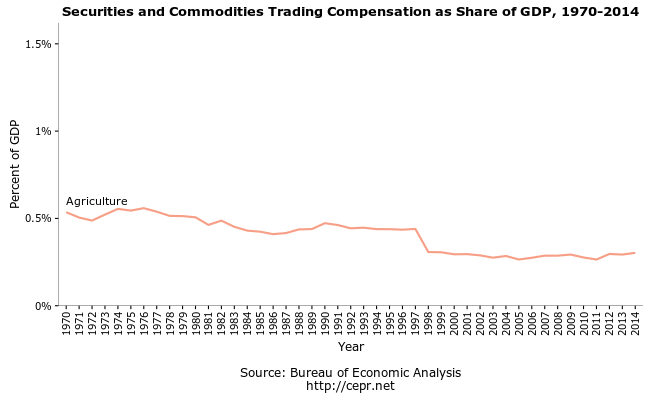July 28, 2016
Representative Peter DeFazio (D-OR) recently introduced a new bill (H.R. 5745), “Putting Main Street FIRST: Finishing Irresponsible Reckless Speculative Trading Act.” The purpose of the bill is to curb high-volume speculative trading. In the bill, this is accomplished by imposing a small tax on financial trades.
The tax, known as a Financial Transactions Tax (FTT) or Wall Street Speculation Tax (WST), would be assessed at 3 basis points, or just 3 cents per every 100 dollars traded. The tax would primarily impact traders and suppliers of financial services. The main effect for consumers is that they would spend less in total trading costs, as they reduce trading volume in response to the tax.
At 3 basis points, the revenue would be $417 billion in revenue over the next decade according to the latest estimates of the Joint Committee on Taxation (JCT). Just as importantly, the tax could increase the efficiency of the financial sector.
Over the years, the size of the financial sector has grown considerably. Consider the figure below. The bars show the growth of the securities and commodities component of the financial sector since 1970. This is contrasted by the red line which shows the size of the agriculture sector over this same period of time. In essence, this growth is the additional cost of compensation for highly paid people working in the financial sector as well as computers, office space, and other capital that they use.

But as a recent report by CEPR’s Dean Baker notes, there is little additional benefit to the economy from this increased spending. Over the past 45 years, the growth in the size of the financial sector has not demonstrably eased the transfer of capital from savers to businesses that invest to families that want to borrow for college, a car, or a new home. In other words, this additional spending in the financial sector is essentially economic waste and could better serve the economy if allocated elsewhere.
An FTT structured at, or near, the level of the DeFazio bill would rein in the size of the financial sector to levels we saw in the 1990s, a time in which it’s hard to argue that the financial sector did not meet the needs of the economy. At the same time, this would reduce excessive liquidity and volatility while raising a substantial amount of revenue.






